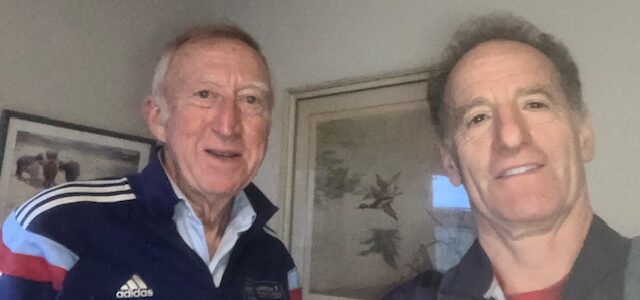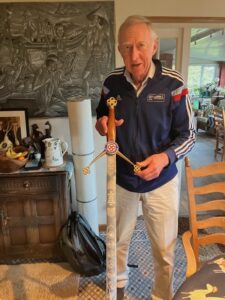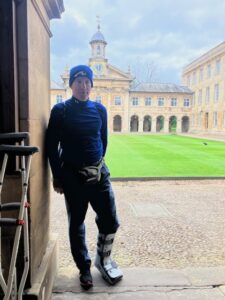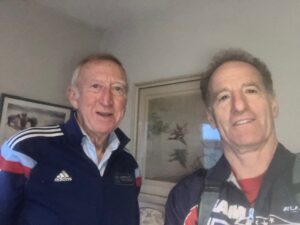
Superstar athlete, all-around sportsman AND Coach!

Pitting athletes from different sports against each other in a variety of events was a wonderful concept that actually took place in the 1970s. Doug Landau fondly remembers the ABC Superstars competition, where basketball players, boxers, track athletes, race car drivers, soccer stars and other great sportsmen(& women) would challenge each other in a variety of events. It was one of Doug Landau’s, as well as his friends’ and family’s, favorite sporting events to watch on television. Landau was so enamored of this competition, that he and his friends would make up their own events, and compete in their own “Superstars competition!”
Landau remembers the Superstars as featuring the ten top athletes from ten different sports competing in an assortment of events that most everyone would be familiar with (& probably do!). The television show first aired in 1973, with Olympic gold medal winning Decathlete Bob Seagren winning the title that first year. Thereafter, American soccer star Kyle Rote Jr. won in 1974, 1976 & 1977. Rote earned a total of $185,000 from his three Superstars victories (compared to $8,000 a year as a U.S. soccer player!). Great all-around athletes like world record setting hurdler and football player Renaldo Nehemiah won 1981-83 & 1986, and football player Herschel Walker won 1987-1988.
In late 1973, a similar event appeared in England, and later, Superstars competitions were being held in nearly a dozen countries including Australia, Canada, Ireland, Netherlands, New Zealand and Sweden. The U.S. Superstars version grew to include women, entire sporting teams, and celebrities. In order to be successful in the Superstars competition, you not only had to be very strong, coordinated, and aerobically fit, but you also needed to have had a well rounded sports background. This was proved to be true when world heavyweight boxing champion Joe Frasier jumped in the pool for the swim competition, and tried to punch his way to the other side! He nearly drowned, and only after he was pulled out of the pool did he admit that he did not know how to swim!

If memory serves, there was also a bike race, running race, steeple chase, weightlifting, a rowing race, bowling, and baseball hitting. The obstacle course was the final event of the original Superstars to determine the overall winner. Landau remembers 7-foot tall basketball legend Kareem Abdul Jabber having difficulty getting over the wall in the obstacle course. He also remembers when “the Incredible Hulk” bodybuilding star Lou Ferrigno lost the weightlifting competition to O.J. Simpson, as the football player knew how to use his legs to drive the weight up, while the nearly 300 pound Hulk tried to use only his arms. These days, we do not see such competitions, as so many athletes are worried about getting injured and ending their multi-million dollar careers.
In Europe, the Superstars competition had a slightly different format. There were gym tests like doing as many dips or squat thrusts as possible in a minute, as well as steeplechase, cricket batting, kayaking, soccer penalty kicks, and pistol shooting. Athletes were assembled from sports like soccer, race car driving, boxing, and track & field. Doug Landau’s Boston University track coach and British Olympian David Hemery was a competitor in the first Superstars competition in the United Kingdom. Hemery had won a gold medal and set a world record in the 400 meter hurdles at the 1968 Olympics, and then won silver and bronze in the quarter mile hurdles and 4 x 400 relay respectively at the 1972 Olympic Games. As an amateur athlete, Hemery was not allowed to keep prize money during his Olympic training days. But, in 1973 he was permitted to compete at the Superstars and keep the prize money he earned as the overall winner at the inaugural competition. He was runner up in 1974, and then won again at the next Superstars competition held in 1976. David Hemery was also runner up at the 1975 European Superstars Competition, the 1983 UK Past Masters championship and was recognized as Britain’s best “Superstar” from 1973 to 1977.
After his Olympic and Superstars participation, David Hemery returned to his alma mater and became an athletics coach. He was the head track coach at Boston University for 17 years, from 1981 to 1998. He achieved significant success during his tenure, including leading the Boston U. Terriers track team to NCAA Championships. He was adroit at recruiting top track & field athletes from all over the Commonwealth countries to race at the Nickerson Field and Armory tracks, located off the appropriately named Commonwealth Avenue! In fact, so beloved was Coach Hemery, that one of the top track meets in the country is named the “David Hemery Valentine Invitational.” Hosted by Boston University, it is a prominent indoor track and field meet that takes place annually at the Boston University Track and Tennis Center. The now famous indoor event attracts top collegiate and professional athletes, with a focus on fast times and record-breaking performances due to the track’s unique banked design.
Coach Hemery kept himself in such excellent shape, that he would run the track team workouts with the college students and more than keep up. His advanced training programs helped runners find their speed, strength and stamina. Doug Landau was lucky enough to be allowed to tag along during his short tenure at Boston University. Landau still does the uphill intervals, sand runs, and downhill overspeed workouts he learned under Coach Hemery’s tutelage.
“Being able to run on the same track as Bobby Danville, Sharon Colyear, John Wilson and other great runners really inspired me to go fast. Plus, professional runners from the Greater Boston Track Club were also there training, which further fueled the fire to give your best. I had not been running very long, but our very fast indoor track pushed me to my limits. Plus, Coach Hemery kept a positive outlook, was a brilliant font of information and was the consummate gentleman. He even came to the Boston Marathon party I threw in my dorm – in a suit!”

Landau was inspired by David Hemery and has been running ever since his days at Boston University. Hemery was also instrumental in Landau becoming a long-time wear tester for a major running shoe company. Hemery saw Landau’s interest in sports medicine (and graduate work in Applied Anatomy & Physiology), and knew he would be good at keeping track of the necessary data and giving good feedback as a “human guinea pig” for this cutting edge company. In return, Landau got shoes and other sports gear for over a quarter century, and was even able to meet the scientists on the West Coast who examined his clothing under microscopes and analyzed his distances, times, and training conditions on his air soled and other specialized trainers. Coach David Hemery’s impact on so many lives is a testament to his drive for excellence, empathy and intellect. Landau notes, “Coach Hemery ‘walked the walk,’ by training WITH us, thinking through our training deeply, and he always exhibited his professionalism, class, and sense of humour. I hope I have made him proud.”
